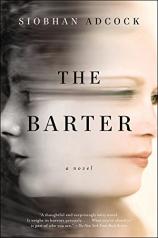Reading Group Guide
Discussion Questions
The Barter

1. THE BARTER offers readers two portraits of marriage and motherhood, one in the present day and one at the turn of the 20th century. How do these representations of marriage and motherhood diverge and in what ways are they similar? How do Bridget and Rebecca each struggle with or rebel against their roles as wives and mothers, and how do each of them embrace those roles?
2. Both Rebecca and Bridget are depicted at times as closed off and even terse. How do their personalities compare with their respective husbands’? What might those comparisons highlight about gender roles in THE BARTER?
3. Why do you think Mark doesn’t see the ghost?
4. Compare Mark and John. How do they each approach marriage and fatherhood?
5. Two recurring motifs throughout the novel are suffocation and hunger, along with the desire to nourish. Discuss how hunger and nourishment are represented in the novel, through symbolism, language, action and description, and talk about how these themes might relate to the topics of motherhood and marriage.
6. The sense of smell is important throughout THE BARTER. For example, smell is employed in the opening chapter to powerfully establish a dichotomy between the novel’s representations of baby Julie and the wet stench of the ghost. Why is the smell of the ghost so forcefully emphasized here? Do other senses play as strong a role?
7. Describe Bridget’s relationship with Gennie. How does Gennie affect Bridget?
8. Describe Rebecca’s relationship with Frau. How does Frau influence Rebecca?
9. What personal desires and needs do Bridget and Rebecca, respectively, end up giving up? What do they gain?
10. Discuss how Bridget and Rebecca, respectively, respond to the supernatural occurrences in the novel and how their reactions change over time.
11. Both Rebecca and Bridget are the products of single-parent households. Rebecca was raised by the doctor, while Bridget had only her mom. How do their respective relationships with their parent affect each woman’s own parenting choices?
12. Storytelling plays a key role throughout the novel, from Bridget creating stories for Julie to Frau’s tales for Rebecca. Discuss how storytelling informs the characters’ reality and choices.
13. Bridget seems to be attracted to the presence of the ghost. She says so in the concluding sentence of Chapter One (page 28). She remains in her home when she could flee. What does this say about her character?
14. Ghost stories often raise the question of a character’s sanity. Throughout the book did you ever find yourself wondering whether the ghost was a figment of Bridget’s imagination? If Bridget isn’t really seeing a ghost, how might that alter your reading of THE BARTER?
15. Throughout the novel the ghost seems to demand of Bridget: “Give me something” (page 118). Bridget leaves offerings for the ghost --- some of them her most prized possessions. How does this theme of offering and sacrifice go beyond her encounters with the paranormal?
16. Discuss the story of the ghost children that the magician tells in Chapter Ten. Why do you think Adcock chose to include this secondary narrative? Why might it be important?
17. What does Bridget’s return to the workforce say about the novel’s representation of motherhood?
18. In the epilogue Mark catches a glimpse of a “figure [that] flickers like a flame”(page 301) --- a figure that is quite possibly the ghost that he could never see before. What does this say about where Mark and Bridget are with their relationship and, more broadly, the resolution of the novel?
19. Now that you have concluded the novel, how does the title, “The Barter,” reflect the larger themes that abound within the narrative?
The Barter
- Publication Date: August 4, 2015
- Genres: Fiction, Psychological Suspense, Psychological Thriller, Suspense, Thriller
- Paperback: 320 pages
- Publisher: Plume
- ISBN-10: 0147516366
- ISBN-13: 9780147516367








